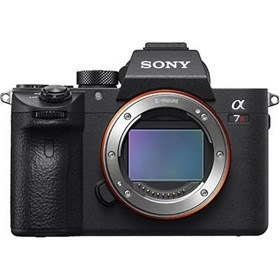We catch up with Lexi Laine, following her breathtaking underwater portrait shoot in the cenotes of Mexico’s Riviera Maya
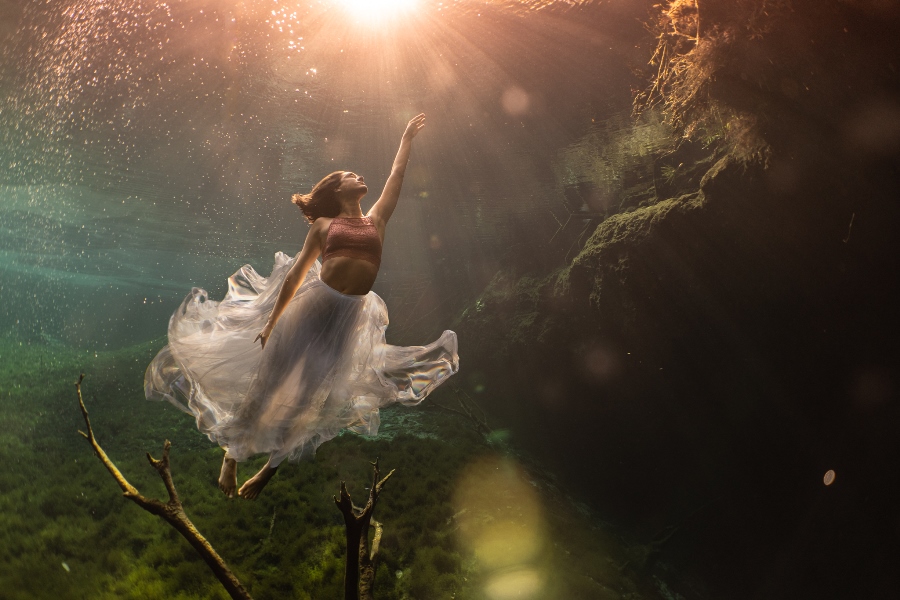
All photography by Lexi Laine.
Lexi Laine’s methodology is almost as mysterious and magical as her stunning underwater portraits. We caught up with the Brighton-based photographer to discuss her full-frame mirrorless setup – Sony’s A7 III and A7R III – and her latest shoot, where she visited the calm waters of Mexico’s incredible cenotes. Read on to find out why Lexi prefers freediving over scuba gear, how she scouts such exquisite locations and what happened when she stumbled upon a snoozing crocodile…
I strive to capture the beauty of natural aquatic landscapes and that true feeling of freedom I experience underwater.
Wex Photo Video: How did you get interested in underwater photography?
Lexi Laine: I’ve been a photographer for around thirteen years now and it really has been the most amazing job for me. These days I specialise in underwater fine art photography, although I also love shooting weddings and portraits on dry land too. The variety is one of my favourite things about what I do – I meet new people during every shoot and get to visit interesting locations around the UK and beyond.
I got into photographing people underwater because I wanted a new creative challenge that would be a bit different from my other work. My love for the ocean, and everything that comes with being underwater, has always been an opportunity for me to relax and enjoy a world that’s so different to dry land.
As a child, I would spend my whole holiday in the sea. I remember having those underwater disposable film cameras that you used to get back in the 1990s – the ones where you’d get the photos back after your holiday and everything would be a bit blue/green – they never captured the brilliance of what I saw down there. Nowadays, I strive to capture the beauty of natural aquatic landscapes and that true feeling of freedom I experience underwater.
W: What would we find in your kit bag for underwater photography?
LL: Up until last year, I used to have two different setups. I had a pro-level DSLR system that I used for shooting portraits and weddings on dry land, and I used a Micro Four Thirds mirrorless system for all of my underwater stuff. Around March 2018 I decided to make the switch to Sony for its full-frame mirrorless capabilities, and it made sense to me that I could sell all of my previous gear and have one system that I could use both underwater and on land.
For the first time in my adult life, I only own two cameras. I currently shoot on a Sony A7 III and A7R III, combined with an underwater housing that has been designed specifically for both cameras. It’s really refreshing to have a system that is lightweight and perfect for all of my photography jobs.
Obviously I wear a mask when I’m shooting underwater, so I find it much easier to compose the image on the rear screen rather than the viewfinder. That means a mirrorless camera is essential for this part of my work. It’s also great to be able to see the exposures I’m getting as I shoot – I’d definitely miss that feature if I went back to shooting on a DSLR.
The A7 III and A7R III both have dual card slots, which is another essential feature for me. The shoots that I do involve a huge amount of time and money to put together, so if a memory card were to fail then reshooting would be a very costly thing to do. I’ve only ever had one memory card corrupt in the years I’ve been a photographer, but that one time made me realise how important dual card slots are.
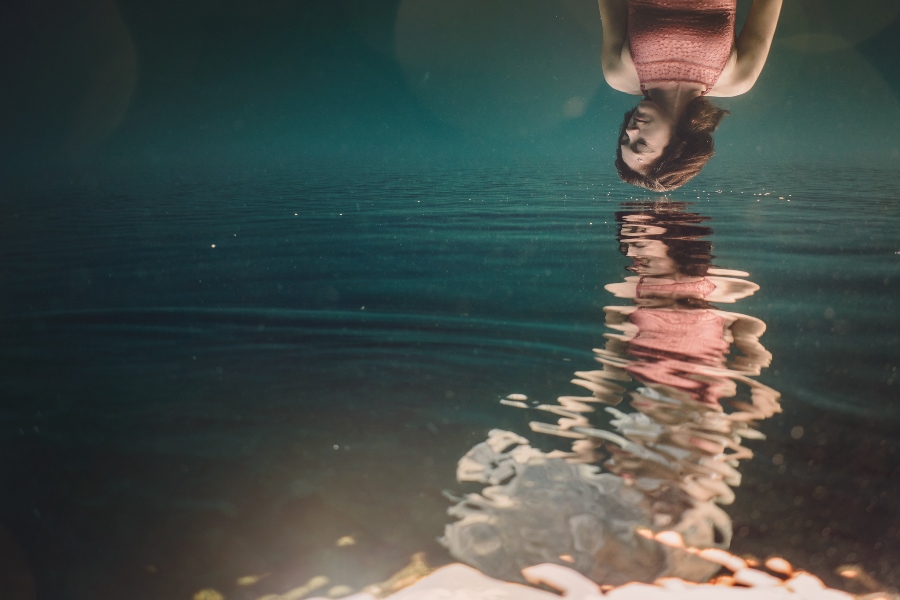
W: Can you recommend a particular underwater housing for anyone who might be interested in trying underwater photography themselves?
LL: I use a housing made by a company called Nauticam and I have also used housings made by Ikelite. These brands are the best I’ve experienced in regards to build quality and reliability. They both design housings for specific cameras, so you still get full control of whatever camera is inside. For me, that means I have use of the Sony cameras’ brilliant focus system, which has made such a difference in the technical accuracy of my underwater work.
I’ve set up all of the custom function buttons and memory recall settings on my cameras, so I can make really quick settings changes while underwater. As you can imagine, time is of the essence, so it’s great not wasting precious moments having to go through a menu system. Any good underwater housing should allow you access to all of these controls, so it makes operating your camera no different from shooting on dry land.
I’ve set up all of the custom function buttons and memory recall settings on my cameras, so I can make really quick settings changes while underwater.
Another great feature of the Ikelite and Nauticam housings is that you can add a vacuum valve into the setup, which is an additional watertight safety feature. Basically you can pump all of the air out of the housing, and if for any reason this vacuum is compromised and starts to leak, then a built-in alarm system will sound. This allows you to get out of the water before your camera gets wet. Thankfully, this has never happened to me but it’s a reassuring feature nonetheless!
For every housing system you also need to purchase a port, which fits onto the front of the housing. They’re all different for each lens, and my favourite is the Sony 28mm f/2, combined with a dome port. It’s a really lovely little lens that’s quite compact, so it makes the whole setup not too big and quite manageable to handle underwater.
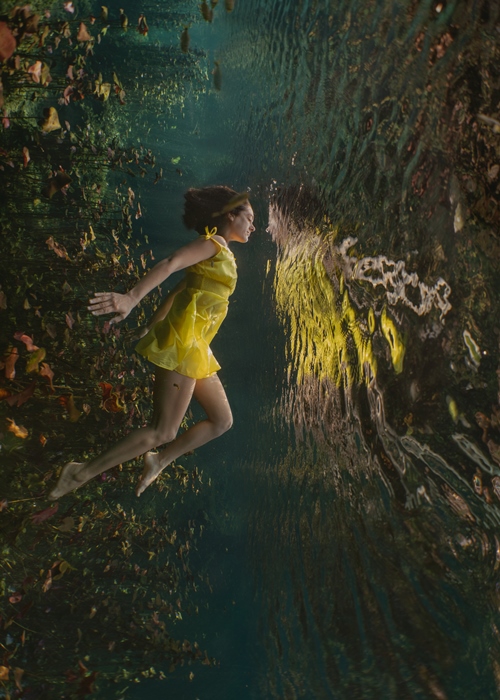
W: What made you travel to Mexico for this shoot?
LL: I first visited Mexico five years ago, and since then it’s been on my bucket list as a destination to shoot a big underwater project. When asked to make a short behind-the-scenes video about how I work, I could think of no better place to film one. The locations we made this film in were the incredible cenotes in the Riviera Maya. In this area, all of the river systems run underground.
Cenotes are basically sinkholes that appear when the limestone bedrock collapses and exposes these perfect little clear water pools. There are around 6,000 of them in the region, so we were spoilt for choice. There’s a lot of history behind them too; the ancient Mayans saw these cenotes as gateways to the afterlife so they would often throw valuable items and sacrificial offerings into them. Skeletons have been found in many of them, apparently!
I find the history behind these beautiful pools to be really fascinating and it definitely inspired me to take photographs that have an otherworldly feel. The cenotes also had turtles and thousands of tiny fish swimming around, so it was a dream location for me.
W: You choose to freedive, wouldn’t it be easier to use scuba gear?
LL: I know that a lot of photographers who do underwater portraiture find it easier to use scuba equipment. While I do enjoy scuba diving as a sport, I much prefer freediving as it allows me more freedom, believe it or not. I can move a lot more easily than if I’m wearing a buoyancy control device and tethered to big tanks. It also offers me a much better connection to my environment – I feel like I’m part of that world if I’m wearing just a swimsuit or rash vest, there’s no separation, no disconnect.
I much prefer freediving ... I can move a lot more easily than if I’m wearing a buoyancy control device and tethered to big tanks.
I’ve always shot this way, so last year I decided to take my freediving skills up a notch by joining my local club. I now train with an amazing group called NoTanx, based in London and Brighton where I live. I joined the club thinking it would improve my photography, because I’d be able to stay underwater for longer periods. But, what I’ve really benefited from more than anything else, is finding a passion for a sport that makes my heart sing. I feel incredibly lucky to have found something that helps me with my photography work, benefits my health and makes me feel so alive.
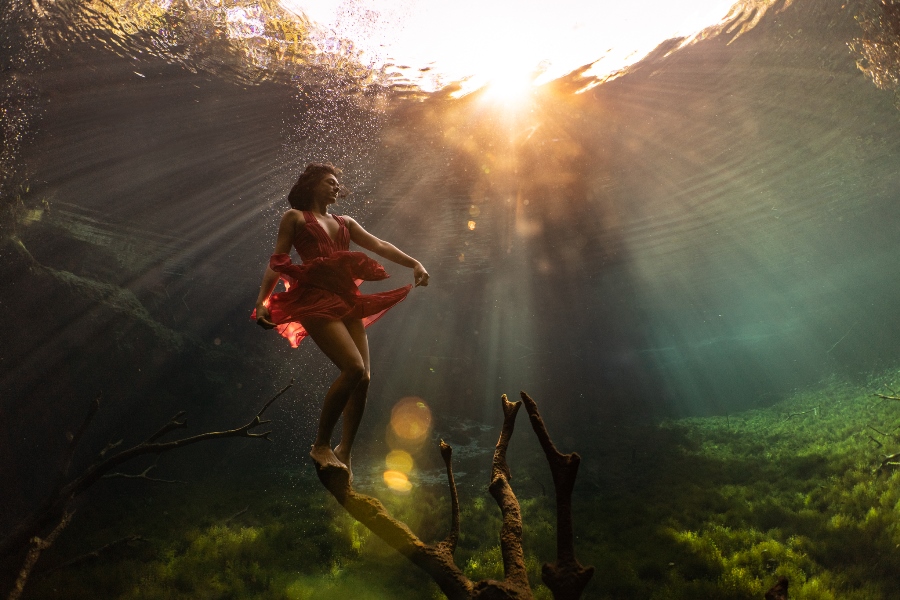
W: How do you communicate with your models underwater?
LL: This is another benefit of freediving, rather than using scuba gear. A lot of the directing happens when we are on the surface, in between dives, so it makes sense that I have no advantage of being able to breathe underwater with tanks. My favourite model and friend, who features in this film, is a real natural underwater. Her name is Iara, which actually means mermaid in Brazilian mythology!
We get together several times a year to make new work. Over the years we have built up a real understanding of one another, so it makes what I do a lot more fun. I sometimes think she can read my mind when we are deep under the surface. I usually give quite detailed instructions as to where I want her to dive to and the poses when she’s reached the right position, but what plays out from there is beyond my control.
I can’t direct her once we’re down there and she can’t even see me to make eye contact, so it’s definitely a challenge. I think what really helps is that she understands my vision and knows me well enough to understand the feeling I want to capture in the images.
W: What challenges did you face while shooting the project?
LL: I think the main challenge was access to the locations. I spent three days driving from one cenote to the next, literally dipping my face in the water to see what it looked like and then moving on to the next one. I had a checklist of all the things I was looking for, so it was fun trying to find places that had everything I needed. Some didn’t have clear enough water and some were too ‘touristy’ so we’d get people swimming around in the background.
On one of our shoots I spotted a really huge crocodile having a snooze about two metres away from us…
All of the cenotes were privately owned and had different rules in place – one of our favourite locations had a no fins rule, which made it a lot more challenging for me to move about quickly in the water. Luckily, I like a challenge so it was good to embrace different ways of working. On one of our shoots I spotted a really huge crocodile having a snooze about two metres away from us… I guess that was a challenge I wasn’t expecting, and we decided we should probably get away from there as quickly as possible, just in case!
We were really lucky to have an amazing filmmaker, Ollie Putnam, come on this trip with us to make the behind-the-scenes film of us working together. Ollie uses scuba equipment for the projects he normally works on, but the cenotes had rules in place that prevented him from doing so without paying a lot more money for the privilege. So, he ended up shooting the whole thing while freediving, which was very impressive I think!
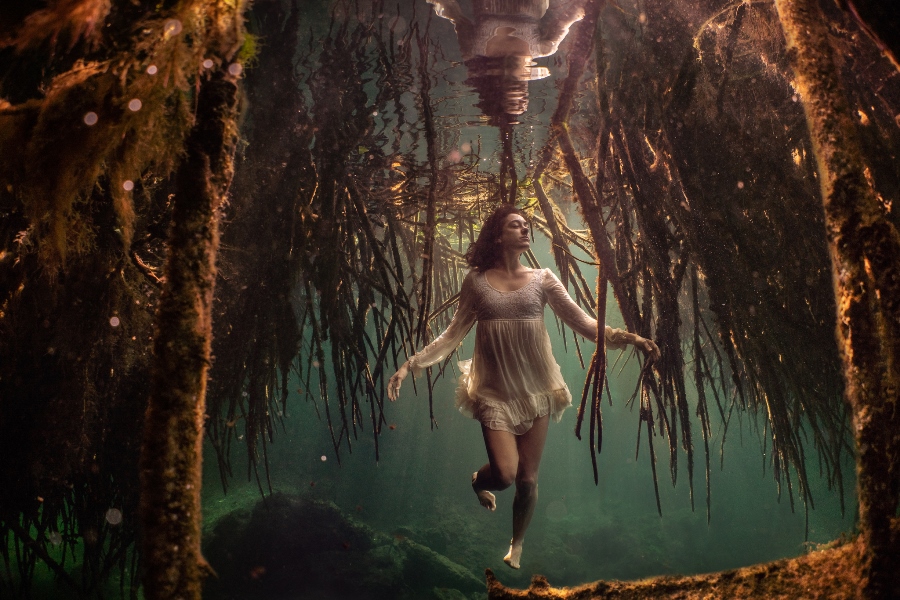
W: You often shoot in the sea; what challenges did you face when shooting inland?
LL: I think shooting in the sea definitely has its challenges, but also has many advantages. The most important thing for my photography is to find crystal-clear water, and the hardest thing to find is locations where the visibility is good. In the sea, it’s very dependent on the weather.
If conditions aren’t quite right then shoots can often be complete failures. If it’s too rough sediment can be churned up, and that makes it murky and hard to focus. Sometimes the right conditions come along, we have perfect light and I think this will be a great shoot, only to get into the sea and find we are surrounded by jellyfish. This normally means we need to abort the shoot, so the failure rate can be pretty high.
That said, I would much rather take photographs in natural environments. Although they are less reliable than, say, a swimming pool, the topography of natural underwater landscapes is an essential element of my photographs. Another thing I just love about working in the sea is the depth of some of the locations. Locations where the sea is twenty-plus metres deep give me a lot more space to work in – I can create images that really show the vastness and mystery of the ocean.
One thing to mention that’s very important is the risk factor of taking photographs in the sea or any underwater environment for that matter. The first rule of any form of diving is to never dive alone, so for anyone who is reading this and wants to try out underwater photography, I recommend having at least one buddy with you at all times. And, I always ensure whoever I’m working with is a strong swimmer before working in deep-water locations.

W: Where would be your dream location for a shoot?
LL: My favourite locations are in the Mediterranean Sea. There are some amazing places where the water is just turquoise and clear. I know these areas so well, I can predict where will be great to shoot, depending on the direction of the wind on any particular day. It’s great having go-to locations where the success rate is much more likely.
Going to new locations usually means a lot of my time is taken up driving, hiking, climbing and swimming to research the best spots. This is something I really love doing and I think the more I push myself to try different things then the more likely it is for my work to keep evolving. So yes, I have a longlist of places I want to go. Places like the Gili Islands in Indonesia or the Florida Springs are at the top right now.
…not wanting to have a massive carbon footprint due to long-haul flights is something that is high on my mind. I limit my long-haul trips to once a year maximum…
Finding the time and money to visit new places is a drawback, and not wanting to have a massive carbon footprint due to long-haul flights is something that is high on my mind. I limit my long-haul trips to once a year maximum and try to shoot as much as is humanly possible in the time I have, when I’m there. This year I have trips planned to Cornwall and Wales, so I can hopefully find spots in the UK where the water is clear enough to work in. I’ll just have to get used to slightly cooler water temperatures!
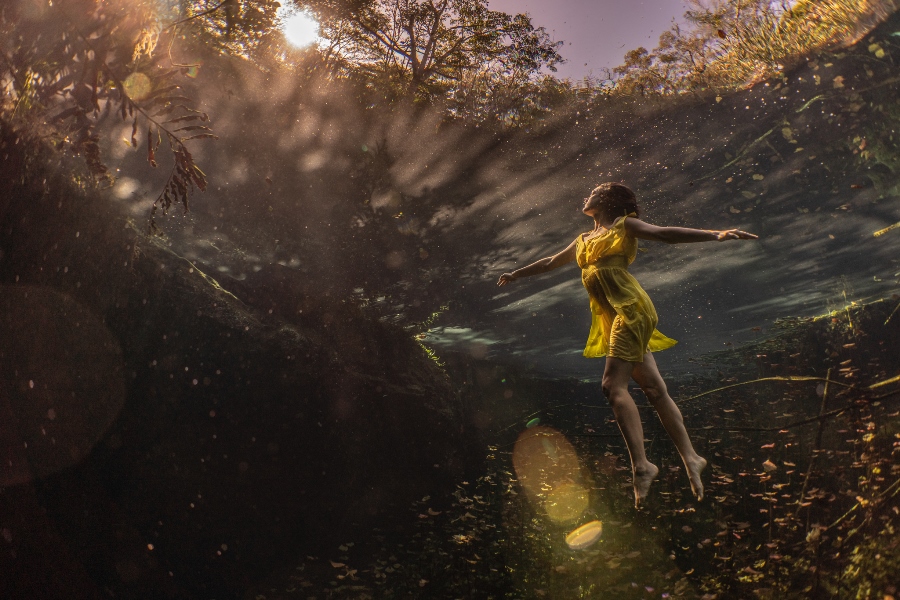
W: What sort of editing techniques do you use to keep the magical feel of your images believable?
LL: I used to spend far too much time in Lightroom and Photoshop, trying to get the colours right in my photographs. The way light is absorbed in water means that red and orange colour tones are reduced quite dramatically, the further away from the surface you go. That’s the reason why underwater photos often look quite blue/green when they are straight out of the camera. There are ways to prevent this loss – such as using strobes or video lights – but I really love using natural light, where the only light source is the sun.
For me, the sun is quite symbolic in my images and I’m not a fan of taking anything away from that by using additional light sources. Using a red filter on your lens is another way of helping to reduce the bluish tint. Over the years, I have developed my own presets. They work really well at correcting the colours, so thankfully my time in post is much quicker now. I have found the colours of the files that I get from my Sony cameras to be so much easier to work with too.
I normally deliberately underexpose my shots by several stops to reduce the risk of blowing highlights and then pull back the shadows when I’m processing the images. With my previous cameras, this resulted in some pretty dodgy loss of detail in the darker parts of the frame, but the A7 III and A7R III are great at handling that amount of pushing. The only other thing that sometimes takes a bit more work in Photoshop is removing distractions from the image.
I try to keep things as true to life as possible, but occasionally I might airbrush the odd air bubble out of a shot – especially if it interrupts the view of a facial feature. My aim is to create images that draw in the viewer, make them feel like they are in this other world and to hopefully spark an emotional reaction, which can vary for each individual. The underwater world is naturally the most beautiful place I have found to shoot in, so my goal is to capture it as true to life as possible.

Sony A7 III Digital Camera Body
